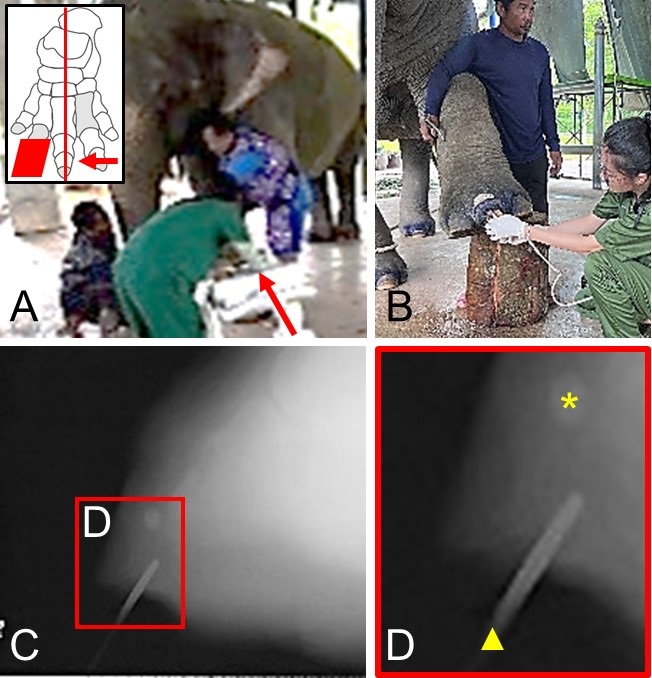Traumatic toenail wound in a Thai elephant (Elephas maximus indicus)
Toenail wound in elephant
Abstract
Elephant is Thailand’s national animal which represents three aspects: loyalty, longevity, and strength. Thai elephants are often used for deforestation and tourist activities, such as elephants, riding, and showering. This case report highlights a traumatic wound in the left foreleg nail of a showering Thai elephant. Nail wounds undergo infection and tissue necrosis. A bone fragment suspected to be part of the distal phalanges was found and confirmed by X-ray examination. However, a surgical approach is not recommended because of the high risk of sedation in elephants. Routine wound cleaning with antiseptics and topical antibiotics was performed on the traumatic wounds. The bone fragment was removed after necrosis of the surrounding tissues. The prognosis for this case was considered good based on the location and wound condition.
Downloads
References
Bansiddhi P, Brown JL, Thitaram C, Punyapornwithaya V, Nganvongpanit K. 2020. Elephant tourism in Thailand: A review of animal welfare practices and needs. Journal of Applied Animal Welfare Science. 23(2):164-77. https://doi.org/10.1080/10888705.2019.1569522 | PMid:30689409
Fisher JF, Mobashery S. 2020. Constructing and deconstructing the bacterial cell wall. Protein science. 29(3):629-646. https://doi.org/10.1002/pro.3737 | PMid:31747090 PMCid:PMC7021008
Heal CF, Banks JL, Lepper PD, Kontopantelis E, van Driel ML. 2016. Topical antibiotics for preventing surgical site infection in wounds healing by primary intention. Cochrane Database of Systematic Reviews. 2016(11):1-55. https://doi.org/10.1002/14651858.CD011426.pub2 | PMid:27819748 PMCid:PMC6465080
Kubo T, Sakamoto M, Meade A, Venditti C. 2019. Transitions between foot postures are associated with elevated rates of body size evolution in mammals. Proceedings of the National Academy of Sciences. 116(7):2618-2623. https://doi.org/10.1073/pnas.1814329116 | PMid:30692262 PMCid:PMC6377445
Labib AM, Winters R. 2022. Complex Wound Management. Di dalam: StatPearls [Internet]. StatPearls Publishing.
Lüders I, Tindall B, Young D, Van Der Horst G, Botha S, Luther I, Maree L, Bertschinger HJ. 2016. Standing sedation with medetomidine and butorphanol in captive African elephants (Loxodonta africana). The Veterinary Journal. 209:190-192. https://doi.org/10.1016/j.tvjl.2015.07.014 | PMid:26831175
Stiles D. 2004. The ivory trade and elephant conservation. Envi-ronmental Conservation. 31(4):309-321. https://doi.org/10.1017/S0376892904001614
Ubaidillah H, Frantika NS, Purnamasari L, Ulum MF. 2018. Abses pada gajah sumatera (Elephas maximus sumatranus). ARSHI Veterinary Letters. 2(3):45-46. https://doi.org/10.29244/avl.2.3.45-46
Withycombe C, Purdy KJ, Maddocks SE. 2017. Micro‐management: curbing chronic wound infection. Molecular Oral Microbiology. 32(4):263-274. https://doi.org/10.1111/omi.12174 | PMid:27516380

Copyright (c) 2024 CC-BY-SA

This work is licensed under a Creative Commons Attribution-ShareAlike 4.0 International License.
Authors who publish with this journal agree to the following terms:
1. Authors retain copyright and grant the journal right of first publication with the work simultaneously licensed under a Creative Commons Attribution License that allows others to share the work with an acknowledgement of the work's authorship and initial publication in this journal.
2. Authors are able to enter into separate, additional contractual arrangements for the non-exclusive distribution of the journal's published version of the work (e.g., post it to an institutional repository or publish it in a book), with an acknowledgement of its initial publication in this journal.
3. Authors are permitted and encouraged to post their work online (e.g., in institutional repositories or on their website) prior to and during the submission process, as it can lead to productive exchanges, as well as earlier and greater citation of published work (See The Effect of Open Access).

.jpg)















